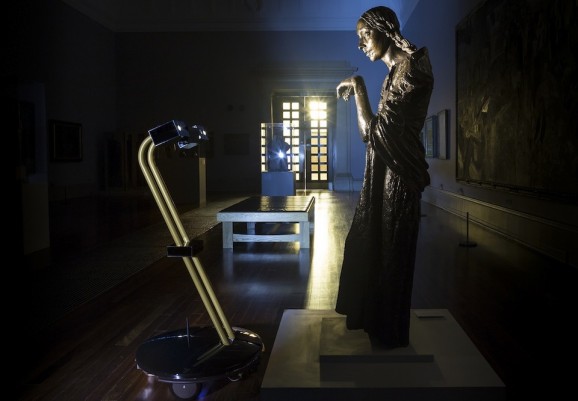Robots Roam London’s Tate Museum After Dark
This article is more than 2 years old
 Ever since I read From the Mixed-Up Files of Mrs. Basil E. Frankweiler, which chronicles the adventures of two kids who take up residence in New York City’s Metropolitan Museum of Art, I’ve had dreams of thwarting security and bunking in a museum (preferably a museum of science, but I’m not picky). Turns out, I’m not the only one. A bunch of robots are fulfilling this dream right now.
Ever since I read From the Mixed-Up Files of Mrs. Basil E. Frankweiler, which chronicles the adventures of two kids who take up residence in New York City’s Metropolitan Museum of Art, I’ve had dreams of thwarting security and bunking in a museum (preferably a museum of science, but I’m not picky). Turns out, I’m not the only one. A bunch of robots are fulfilling this dream right now.
Starting last night, a group of robots are spending five nights in the Tate Britain, examining centuries of British art under the cover of darkness — and on film. The Workers, a design studio that recently won the inaugural IK Prize for their project, developed the idea when one of its members was working on an individual project at the Tate that required him to be there after hours. He found the experience fascinating, just like in the book (okay, maybe not just like in the book, but close enough), and wanted to figure out a way for others to see what it was like.
Not only are four robots exploring the darkened halls of the Tate, but viewers can watch them live, and even take control of them with their computers. Last night I learned that only users operating Google Chrome can actually assume control, and that there’s quite a queue of people wanting to drive (the robots select their drivers). Still, I watched for a good half hour, as a couple of people — I’m assuming they’re Tate employees, as they always knew exactly which work of art a robot was approaching — narrated the robots’ movements. Each robot has a camera, and the live viewing screen shows all what all four robots are doing simultaneously.


Ral Space which provides technical assistance to the UK Space Agency, helped build the robots. They move around on wheels, have sensors to avoid bumping into each other and the artwork, and can look up and down and move in any direction, which selected drivers can control with the arrow keys or on-screen buttons. Because they were specifically designed to navigate the Tate, they’re particularly adept at getting where they want to go. Canadian astronaut Chris Hadfield even gave them a test drive, so you know they’re good to go.
There’s something both haunting and amazing in watching robots interact with art. One of the qualities that sets humans apart from robots is aesthetic appreciation, and among other things, this project challenges that notion.













Leave a comment
You must log in to post a comment